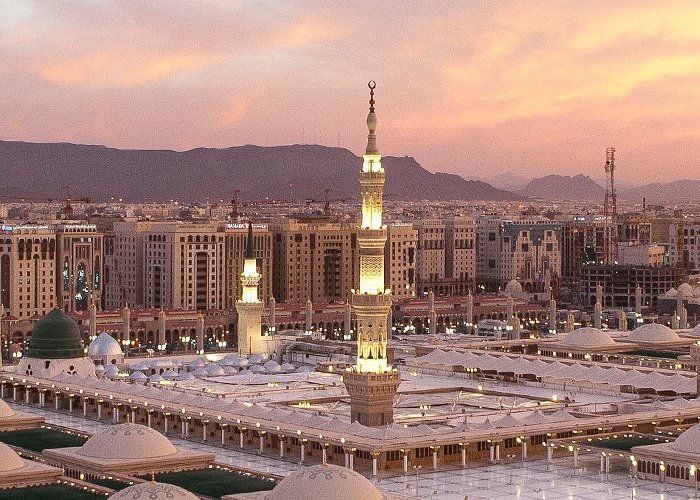
Nestled within the gentle embrace of the Hejaz region in Saudi Arabia, Medina stands as a city of serenity and spiritual significance, second only to Mecca in the hearts of Muslims worldwide. Often referred to as the “City of the Prophet,” Medina holds the honor of being the final resting place of the beloved Prophet Muhammad. Its streets echo with the timeless tales of his life and the early Islamic community, making it a revered destination for pilgrims and seekers of tranquility. Beyond its spiritual allure, Medina is a city that seamlessly intertwines the historical with the contemporary, offering a unique blend of sacred sites, bustling markets, and the warm hospitality of its inhabitants. Join me on a journey through the enchanting streets of Medina, where the echoes of history harmonize with the pulse of daily life, creating an atmosphere that beckons both pilgrims and visitors alike.
The Location of Medina
Nestled in the western folds of Saudi Arabia, the serene city of Medina graces the Hejaz region with its tranquil presence. Positioned approximately 447 kilometers north of the vibrant coastal city of Jeddah, Medina is enveloped by a landscape characterized by vast desert expanses and a timeless ambiance. Its geographical location places it within the cradle of Islamic history, serving as the second-holiest city in Islam after Mecca. Surrounded by rocky hills, the city emanates a sense of peaceful seclusion, providing a sanctuary for reflection and prayer. As a significant stop for pilgrims undertaking the sacred journey of Hajj or Umrah, Medina’s location holds not only historical importance but also a spiritual resonance that draws believers from around the world to experience the tranquility and sanctity that define this revered city.
The History of Medina
Medina, a city steeped in the annals of Islamic history, unfolds as a living testament to the early days of Islam and the transformative journey of the Prophet Muhammad. Originating from the migration, or Hijra, from Mecca in 622 CE, the city played a pivotal role in shaping the Islamic faith. It was in Medina that the Prophet established the first Islamic state and engaged in the drafting of the Constitution of Medina, a groundbreaking social contract that laid the foundation for unity and cooperation among the diverse inhabitants of the city. The Battles of Badr, Uhud, and the Treaty of Hudaybiyyah further etched the historical tapestry of Medina. The city’s streets, mosques, and revered sites echo with the timeless stories of early Muslim communities, making it not only the burial place of the Prophet Muhammad but a living repository of the ideals and principles that continue to resonate through the corridors of Islamic civilization.
Medina’s Significance
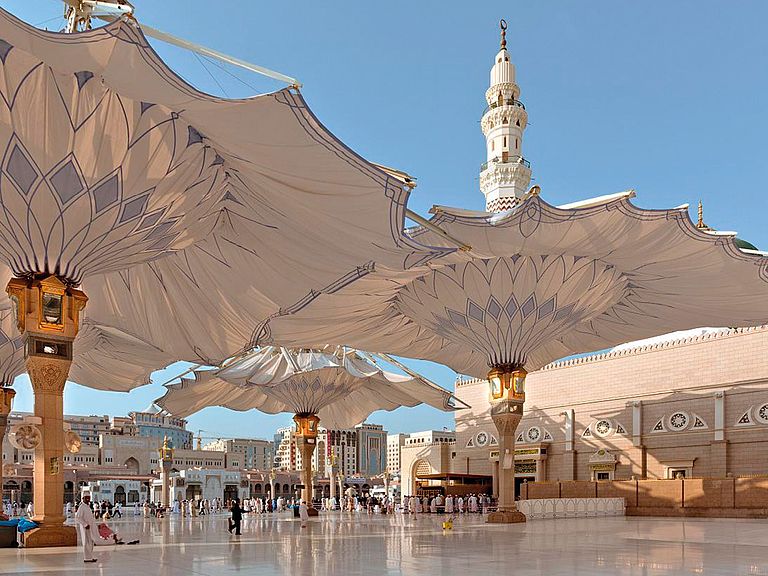
Medina, with its profound spiritual resonance, stands as an embodiment of significance in the Islamic world. Often referred to as the “City of the Prophet,” its importance lies in being the final resting place of Prophet Muhammad. The Prophet’s migration, or Hijra, to Medina in 622 CE marked a crucial turning point in Islamic history, establishing the city as the cradle of the early Muslim community and the birthplace of the first Islamic state. Today, Medina continues to be a beacon of tranquility, drawing millions of pilgrims annually who seek solace, reflection, and a deeper connection to the Prophet’s teachings. The Prophet’s Mosque, at the heart of the city, holds a sacred aura, and the Quba Mosque, the first mosque in Islam, stands as a testament to the city’s enduring significance. Medina’s role in fostering the spirit of brotherhood, unity, and religious tolerance is embedded in its historical heritage, making it an indispensable destination for believers who embark on a spiritual journey that transcends time.
Climate of Medina
Medina, nestled in the arid landscapes of Saudi Arabia, experiences a climate that mirrors the desert environment of the Arabian Peninsula. Characterized by hot temperatures and minimal precipitation, the city’s climate aligns with its geographical location. Summers in Medina, from May to September, are scorching, with daytime temperatures often surpassing 40 degrees Celsius (104 degrees Fahrenheit). Winters, from November to February, bring relief from the intense heat, with daytime temperatures ranging from the mid-teens to mid-20s in Celsius (60s to 70s in Fahrenheit). The city’s climate, though challenging, adds a unique layer to the spiritual journey of pilgrims who visit throughout the year. The historical significance and spiritual allure of Medina rise above the weather, creating an atmosphere that fosters reflection, prayer, and a connection to the city’s rich Islamic heritage.
Site and People of Medina
Medina, with its timeless sites and diverse inhabitants, unfolds as a city where history and humanity converge in harmony. The city’s heart is adorned with iconic landmarks, such as the Prophet’s Mosque, an architectural marvel that cradles the Prophet Muhammad’s final resting place. Pilgrims and visitors alike traverse the historic streets, immersing themselves in the spiritual resonance of Quba Mosque, the first mosque in Islam, and the serene Qiblatain Mosque, where the direction of prayer was changed. Beyond the sacred sites, the people of Medina contribute vibrancy to its tapestry. Welcoming and gracious, Medina’s residents reflect the diversity of the Muslim world, fostering an atmosphere of communal warmth. In the bustling markets, or souks, the air is filled with the aroma of traditional spices, and the vibrant colors of textiles create a lively backdrop to daily life. The people of Medina, deeply connected to their city’s rich history, embody the spirit of unity, humility, and hospitality that defines this sacred destination.
Best Attractions in Medina
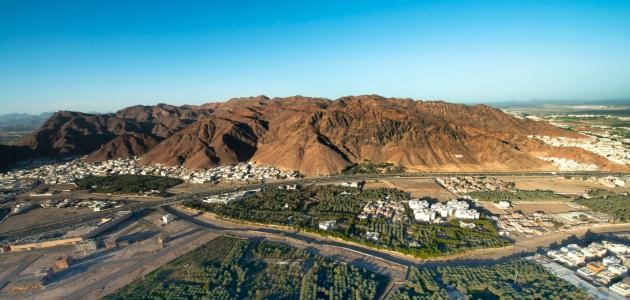
Medina, steeped in spiritual significance and historical richness, offers a treasure trove of attractions that captivate the hearts of pilgrims and visitors alike. At the heart of the city lies the majestic Prophet’s Mosque, a place of profound serenity and the final resting place of Prophet Muhammad. The Quba Mosque, the first mosque in Islam, exudes tranquility and historical importance, inviting contemplation and prayer. Qiblatain Mosque, where the direction of prayer was changed, holds both religious and architectural significance. The dates market in Medina’s bustling souks showcases the region’s renowned dates, a delicious treat for those exploring the vibrant local culture. A visit to Uhud Mountain, where the Battle of Uhud took place, provides a historical perspective with breathtaking views of the city. As a city deeply intertwined with the life of Prophet Muhammad, Medina’s attractions weave a tapestry of spiritual, historical, and cultural experiences, making it a destination of profound significance for seekers of both faith and knowledge.
Best Things to Do in Medina
In the sacred city of Medina, a wealth of enriching experiences awaits those seeking to immerse themselves in its spiritual and historical ambiance. Begin your journey at the Prophet’s Mosque, where the serene atmosphere and the Prophet Muhammad’s final resting place invite moments of reflection and prayer. Take a stroll through the bustling streets surrounding the mosque, exploring the vibrant markets and indulging in the sensory delights of local cuisine. A visit to Quba Mosque, the first mosque in Islam, offers a tranquil retreat, while the historical Qiblatain Mosque beckons with its unique architectural significance. Delve into the city’s rich history by ascending Uhud Mountain, the site of the Battle of Uhud, providing not only panoramic views but also a profound connection to the events of the past. Don’t miss the dates market, where you can savor the renowned local dates and experience the flavors of the region. Ultimately, the best things to do in Medina transcend mere sightseeing; they offer a holistic journey, weaving together spirituality, history, and cultural immersion for a truly transformative experience.
How Good are Saudi Arabia Tours?
Saudi Arabia Tours prides itself on being the best travel agency in Saudi Arabia as proven by our numerous positive reviews.
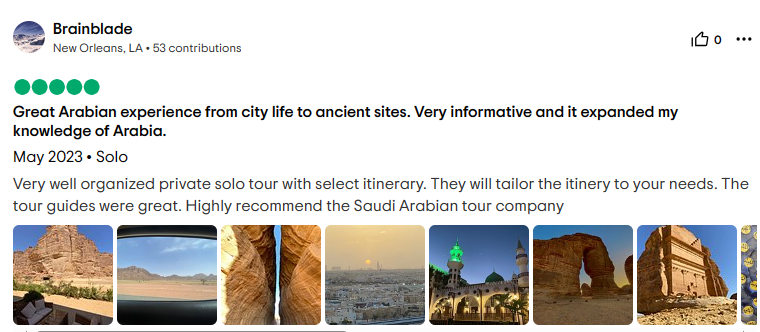
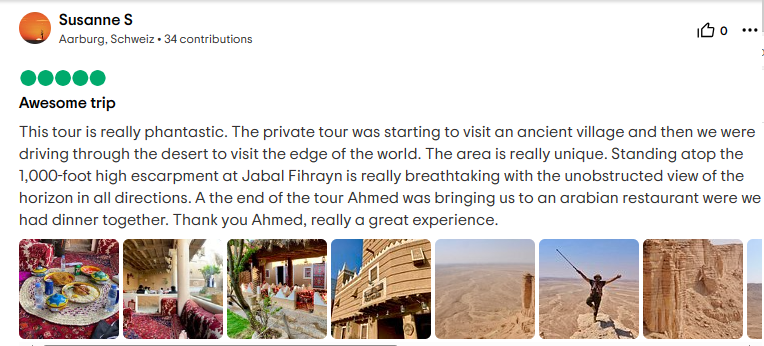

Frequently Asked Questions?
Is Saudi Arabia safe for tourists?
Tourists have been visiting Saudi Arabia and Saudi Arabians have a well-earned reputation for warmth and kindness toward visitors. Saudi Arabia cities are generally very safe, especially in areas where tourists frequent.
How to get a Saudi tourist visa?
Applying for a tourist visa to Saudi Arabia is easy. If you are from one of the 49 eligible countries, you can apply through the eVisa website. Holders of US, UK, or Schengen visas can apply for the visa upon arrival. Saudi Arabia is opening its doors to the world through its new tourist visa. Visitors will have the chance to discover and experience the warm hospitality of the Saudi people, the rich heritage, the vibrant culture, and Saudi Arabia’s diverse and breathtaking landscapes. The visa will be a one-year, multiple-entry visa, allowing tourists to spend up to 90 days in the country.
Are non-Muslims allowed in Saudi?
Non-Muslims can travel to all cities in Saudi Arabia except Medinah and Mekkah, Not allowed to non-Muslims to enter Mecca and Medinah.
Can I wear jeans in Saudi Arabia?
Both men and women are asked to dress modestly in public, avoiding tight-fitting clothing. Women should cover their shoulders and knees in public.
Contact us for more information on:
saudiarabiatours.net@gmail.com
Address: Head Office Olaya St, Riyadh 12213, Saudi Arabia.
If you are booking and taking the tour within 24 hours, or have an urgent request, call us on
Cell/whatsapp : +966558018938 For more info please visit Saudi Arabia Tours

